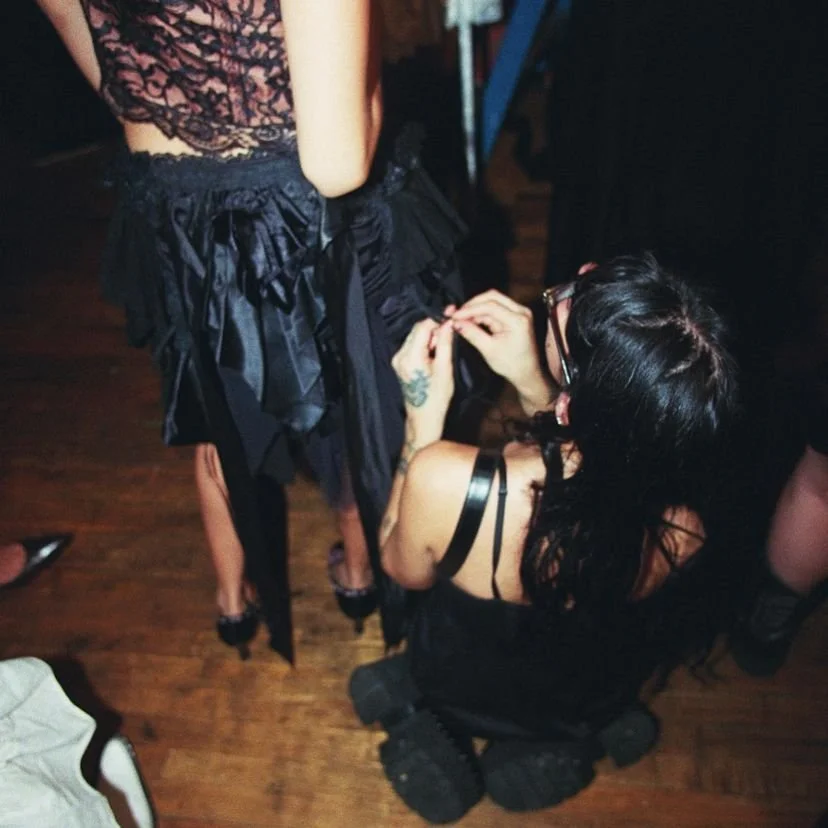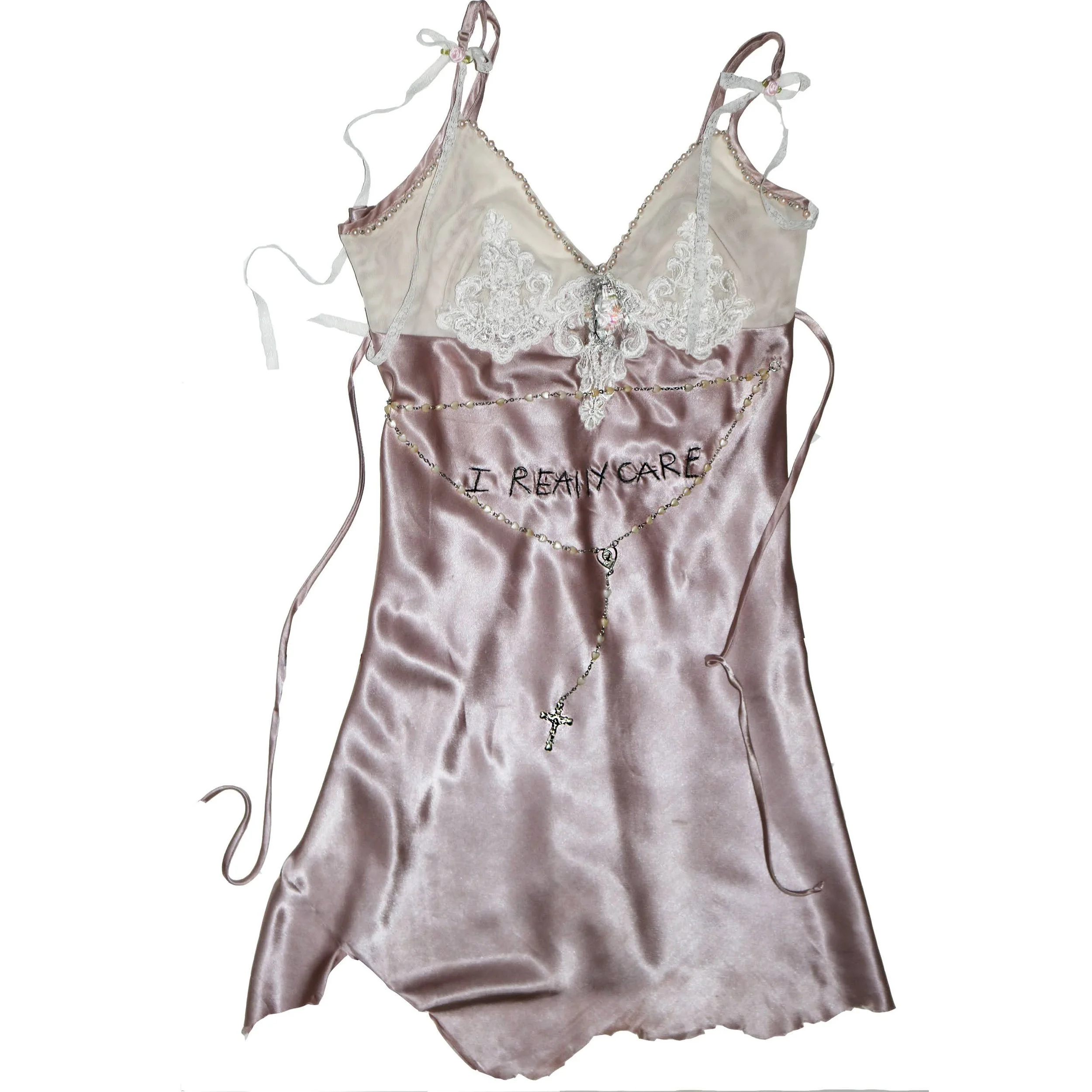Lacing the fashion world with femininity
Whether it’s a collar trimmed in white lace, or a completely sheer lace maxi dress, the decorative fabric has become a wardrobe staple in 2023 and is reminding women of their childhood.
LACE: the openwork web which dates back to the 16th century, has been a key trend in fashion this year. We’ve seen it being upcycled on TikTok into mesh co-ords, walking Simone Rocha’s runway as an avant-garde wedding veil, or maybe tied around a pair of trousers as a makeshift belt. At the heart of this revival? The reminder of nostalgia, girlhood, and femininity.
New York born and raised Sandy Liang is a designer who plays on this nostalgia, reminiscing back to the days of dress up and doll houses in her garments. The Parsons alumna opened her lace-filled brain this June with her resort 2024 collection. Best known for her accents of subtle femininity, a stray bow here and there, Liang’s collection offered a marriage between vintage and modern. Lace bows filtered through milkshake hued dresses, with ruffled hems that were, of course, accompanied by her sought after satin ballet flats.
Liang is new to the fashion scene, starting her brand in 2014. Noting back to her childhood is the forefront of her appeal, the prom queen-esque sash that opened her Summer 2023 show, or the floor length powder pink bows that trailed down the models back in her Resort 24 collection. Much like a young girl tying a ribbon in her hair for the first time, it’s a reminder of this bubbly innocence we all once had.
These hyper-feminine aspects of fashion play on the memories of women’s inner children, whatever that looks like to them. Lace’s popularity could be because of this, and it definitely explains why lace is at the heart of Izzy’s World - a Brooklyn based label founded by former FIT student Izzy DiPietro.
DiPietro’s grandmother was a designer, Barbara Kates, who specialised in lace and showed DiPietro the world of lace as a child. Entwining the fabric with DiPietro’s own experiences is what makes appealing to her, ‘Using lace keeps me close to my heritage, my family is pretty broken, but the stuff we have in common is the fashion design,’ she says, ‘I think that’s my favourite thing about working with lace, the heritage tied to it.’
‘I design for rebellious girls, the girls that wear converse to prom, I just want women to feel represented.’
Izzy’s World comes across as a punk take on modern femininity, DiPietro’s inspiration roots in the Victorian era, but it’s the materials she works with that modernises her work. As she puts it, ‘I might have a design in my head, but if the lace is telling me it wants to do something else, I go with it.’ Using lace allows her ‘to have a broader story in my garment rather than just buying it from the store, I want it to be like “this lady died, and in the excavation of her apartment we found this vintage lace,” it just brings a different character to it.’
DiPietro made her own prom dress - ‘not because I wanted to, because nothing else I tried on felt like me!’ she explains, ‘I like giving representation to women who aren’t represented in fashion.’ She embellishes her own body with lace tattoos, from her hands to her collarbone; lace punctuates her aesthetic and brand. Silk slip dresses branded in sporadically flowing lace trim, embroidered with phrases such as ‘Pay attention to me,’ ‘God’s favourite,’ and ‘Girls 4 Death’, are all just some examples of the work she makes. These rebellious girls DiPietro designs for may well be the same girls within the Coquette or Balletcore groups.
If lace, Lana Del Rey, and Sylvanian families had one thing in common, it would be the obsession that they have on these groups. Amassing over 9 billion views under its hashtag on TikTok, Coquette core has celebrated an aesthetic characterised by hyper-femininity and romanticism. Translating from the French as ‘the woman who flirts,’ the average coquette girl’s wardrobe consists of babydoll tops, lingerie as clothes, and anything stereotypically girly they can get their hands on.
Whilst romanticising ‘girlhood’ is all well and good – it is not without its negatives. These groups have begun promoting some questionable ideas which DiPietro noted: ‘there’s a lot of negative connotations with the groups, from the age gap relationship core and Lolita babygirl, and the eating disorder stuff, I feel like there’s a lot of toxicity.’
So how far can it be taken? Celebrating childhood innocence is only worth appreciating until it becomes oppressive to girlhood itself. Remembering when everything was pastel and glossy is fun, but quickly becomes problematic when romanticisation turns to sexualisation – the line is very thin.
Whether for good or bad, lace’s popularity hasn’t translated to its own industry – lace-making companies are struggling to stay afloat. Cluny Lace, a family bound lace-making company spanning from 3 different generations, was founded by the Mason family in 1845, but the company has dealt with challenges surrounding new Brexit laws.
Making six staff members redundant, and being pushed back in one-hundred years of experience, a representative at the company explained that ‘what once was a straightforward procedure sending lace to and from France to be dyed is now rarely straightforward,’ because of Brexit laws, the company must pay increased fees whenever they import from France. ‘Since our main market is haute couture and based in Europe, we now face many hurdles in accessing that market,’ their representative told me.
Professional lace-maker Tina Pedrick echoed this, ‘as a business [lacemaking] is possibly already dead, unless you get a commission, although I feel it could be endangered if we do not have younger people take it up, most of my students are retired.’ Pedrick began making lace in the 1990s, and now teaches it with the Mole Valley Lacemakers, whom she is currently the chairperson for. Emphasising the importance of recognising the intricate history and art that goes into lacemaking, Pedrick noted the process of lacemaking in conversation.
Beginning by ‘choosing your pattern, creating your pricking,’ which she said is done on card, ‘you then begin adding pairs of thread to the pillow, your bobbins are twisted and more pins are added to enable you to work back across the same bobbins.’ She says the process is finished by connecting both the end and beginning of the lace. The process requires expertise and time – both of which don’t bode well with the fashion industry. As Pedrick mentions ‘we live in a very fast world and most people want a quick return, if not instant, and lace making does not come under this heading.’
‘Although thread and fabric go back prehistorically, there is little evidence of lace as we know it before the end of the 16th century,’ Pedrick explained. Lace began in two forms – Needle and bobbin lace. It was a symbol of wealth, taking months to hand-make. Entering a new era in 1809, the lace-making machine was created, meaning lace could be made at a speed never seen before. The history of lace is certainly bound by political discourse, whether that be the Industrialisation of textiles, or how new laws are forming an even bigger battle for lace makers.
So, what is it that makes lace so appealing now? Whether you are a Lana Del Rey enthusiast wanting to romanticise your wardrobe with lace, or if you just like the way it looks, it is the very essence of lace’s legacy that brings it beauty. Just like Sandy Liang embracing girlhood, or DiPietro referencing back to her grandma’s brand, it brings us closer to our history.
WORDS BY FREYA GOODCHILD-BRIDGE






